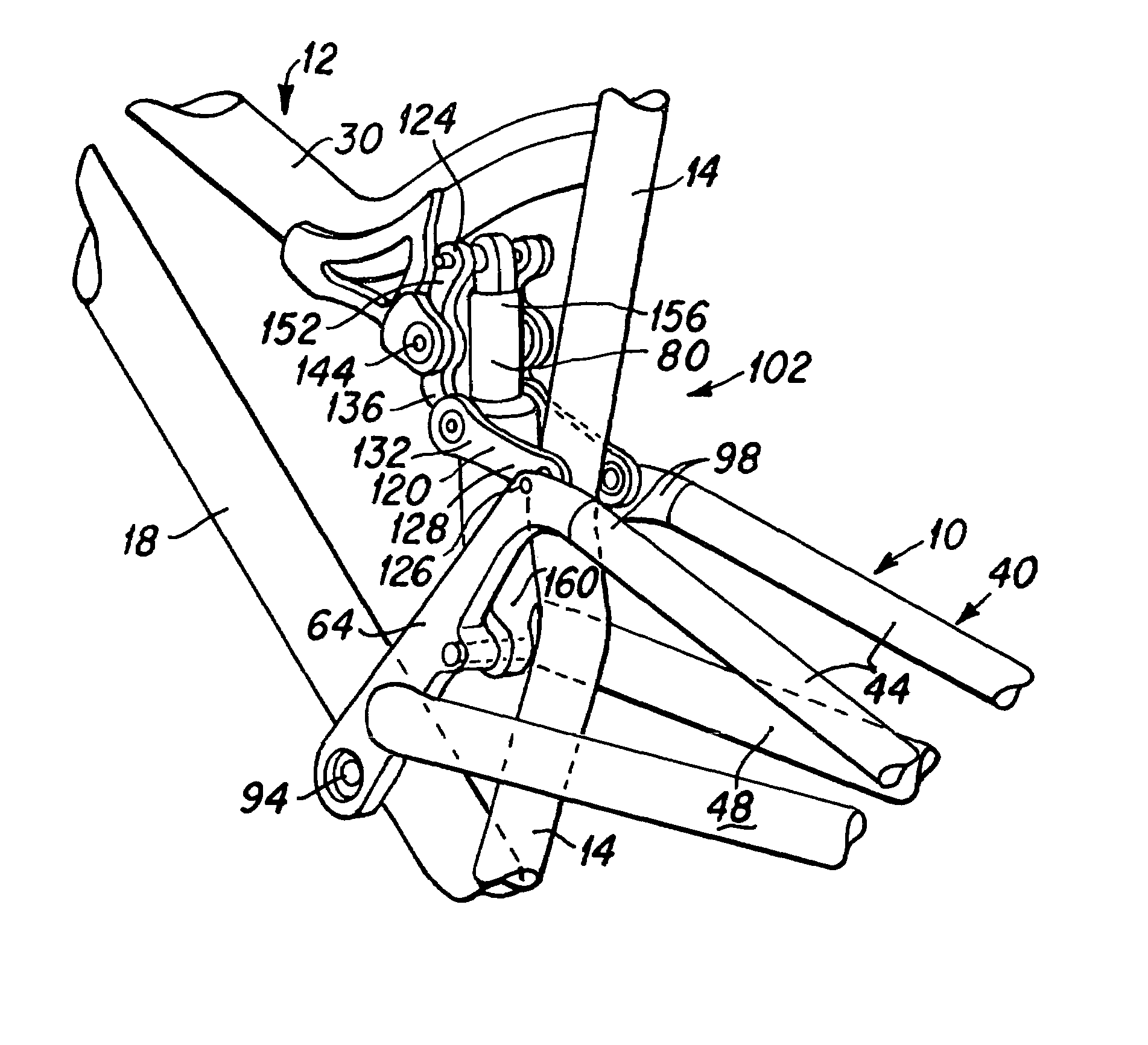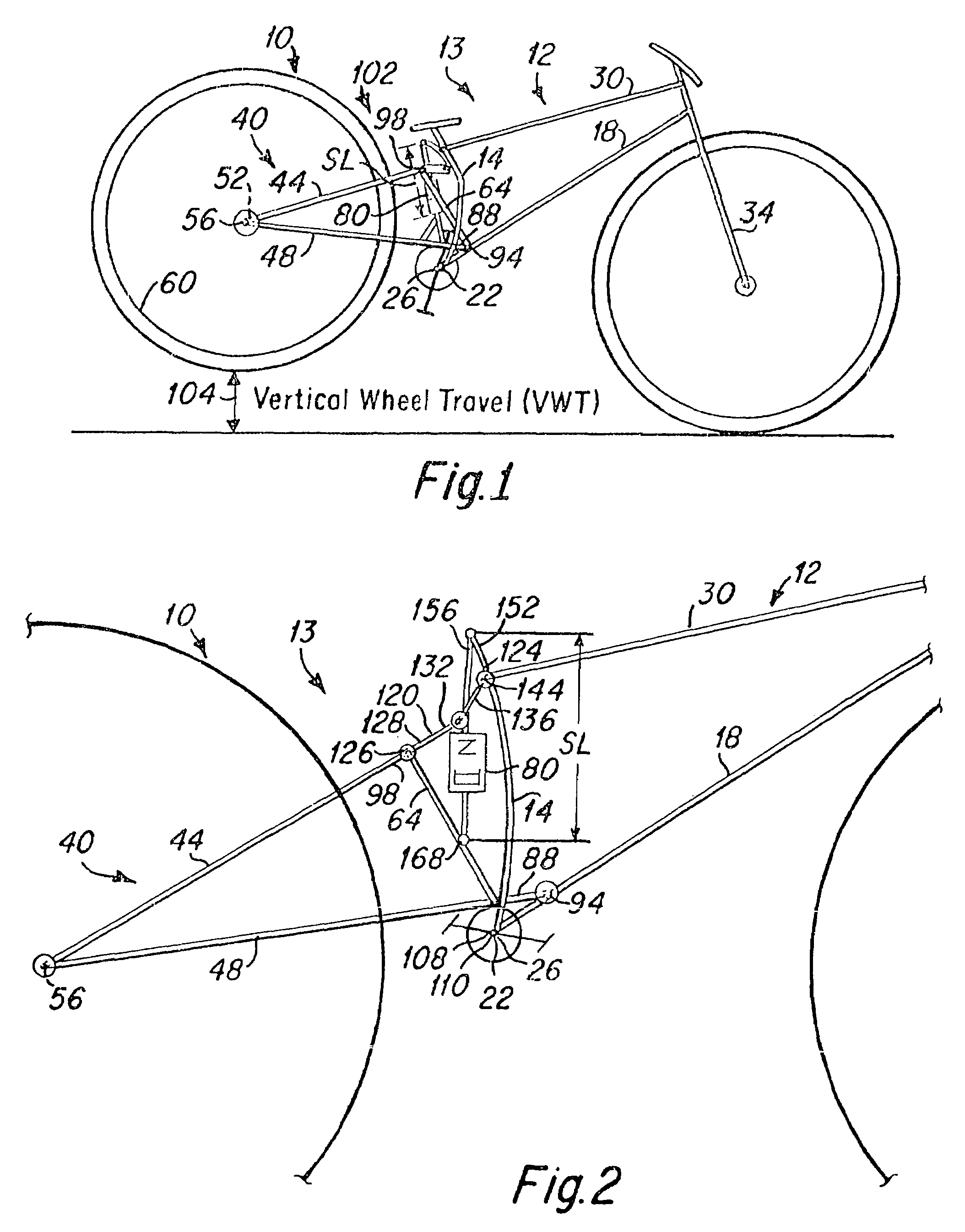Bicycle rear wheel suspension system with controlled variable shock rate
a rear wheel suspension and control variable technology, applied in the field of rear wheel suspension apparatus with controlled variable shock rate, to achieve the effect of improving bicycle control characteristics, increasing traction and control, and increasing rider comfor
- Summary
- Abstract
- Description
- Claims
- Application Information
AI Technical Summary
Benefits of technology
Problems solved by technology
Method used
Image
Examples
first embodiment
[0032]FIG. 1 depicts a rear wheel suspension system 10 engaged with a bicycle frame 12 of a bicycle 13 of the present invention. The bicycle frame 12 generally includes a seat tube 14 and a down tube 18, both of which are attached to a bottom bracket 22 that houses a pedal assembly 26, a top tube 30, and a front fork 34. These elements are typically welded or otherwise secured together to define the frame 12 of the bicycle. Although the frame 12 typically includes all of the foregoing members, alternative embodiments can have more or less than all of the foregoing members, and can include them in various forms, sizes, and configurations, and still achieve the intended functionality and beneficial aspects of the invention.
[0033]The rear wheel suspension system 10 generally includes a rear wheel swingarm 40 that includes a pair of seat stays 44 and a pair of chain stays 48 that are joined to each other at their rearward ends 52 proximate the axle 56 of the rear wheel 60. A pair of fro...
embodiment 13
[0034]In the bicycle embodiment 13 depicted in FIG. 1, the lower frontward end of the swingarm structure 40, proximate the frontward end 88 of the chain stays 48, is pivotally attached utilizing a pivot pin 94 or the like to the bicycle frame 12 proximate the bottom bracket 22, such that the swingarm rotates about the single pivot axis 94. The upper end of the swingarm, proximate the frontward end 98 of the seat stays 44 is engaged through a linkage structure 102 to the bicycle frame proximate the joinder of the seat tube 14 and top tube 30. The shock absorber 80 is engaged with the linkage to control the motion of the swingarm. A detailed description of the shock absorber engagement with the swingarm linkages and the controlled motion of the swingarm is also provided herebelow with the aid of FIG. 2.
[0035]When the bicycle depicted in FIG. 1 is utilized, the rear wheel is designed to move generally vertically upward 104 about the single pivot axis 94 when the rear wheel encounters a...
embodiment 400
[0061]FIG. 10 is a schematic diagram showing another bicycle embodiment 400 of the present invention using a suspension system 402 that moves the rear wheel axle 404 via a swingarm 408 connected to a pair of linkages 412 and 416 that are each pivotally attached at one end to the swingarm 408, and pivotally attached at a second end to the mainframe 420 of the bicycle 400; FIG. 11 is an enlarged depiction of the bicycle 400 depicted in FIG. 10. The frame 420 includes the seat tube 14, down tube 18, and top tube 30, and the swingarm 408 includes seat stays 444, chain stays 448 and front stays 464. The swingarm motion is resisted by a shock absorber 424, such that the shock rate SR varies with vertical wheel travel, and the rate of change of the shock rate dSR / dVWT has a change in sign during the vertical wheel travel, as has been described above.
[0062]As is best seen in FIG. 11, the lower linkage 412 includes a connecting link 430 that is pivotally attached at its rearward end 432 to t...
PUM
 Login to View More
Login to View More Abstract
Description
Claims
Application Information
 Login to View More
Login to View More - R&D
- Intellectual Property
- Life Sciences
- Materials
- Tech Scout
- Unparalleled Data Quality
- Higher Quality Content
- 60% Fewer Hallucinations
Browse by: Latest US Patents, China's latest patents, Technical Efficacy Thesaurus, Application Domain, Technology Topic, Popular Technical Reports.
© 2025 PatSnap. All rights reserved.Legal|Privacy policy|Modern Slavery Act Transparency Statement|Sitemap|About US| Contact US: help@patsnap.com



